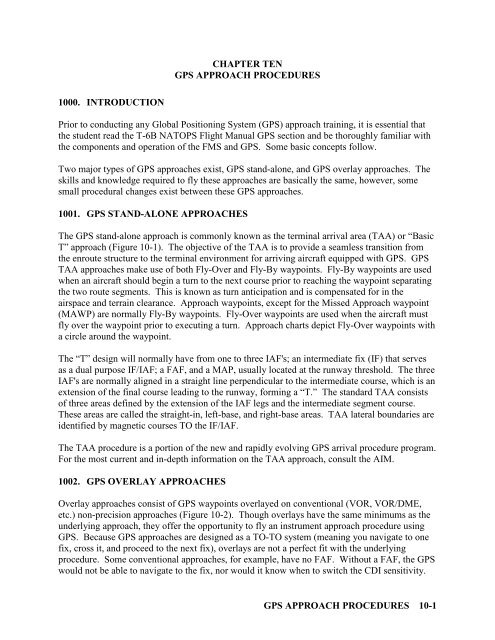Flight Training Instruction - Cnatra - U.S. Navy
Flight Training Instruction - Cnatra - U.S. Navy
Flight Training Instruction - Cnatra - U.S. Navy
You also want an ePaper? Increase the reach of your titles
YUMPU automatically turns print PDFs into web optimized ePapers that Google loves.
1000. INTRODUCTION<br />
CHAPTER TEN<br />
GPS APPROACH PROCEDURES<br />
Prior to conducting any Global Positioning System (GPS) approach training, it is essential that<br />
the student read the T-6B NATOPS <strong>Flight</strong> Manual GPS section and be thoroughly familiar with<br />
the components and operation of the FMS and GPS. Some basic concepts follow.<br />
Two major types of GPS approaches exist, GPS stand-alone, and GPS overlay approaches. The<br />
skills and knowledge required to fly these approaches are basically the same, however, some<br />
small procedural changes exist between these GPS approaches.<br />
1001. GPS STAND-ALONE APPROACHES<br />
The GPS stand-alone approach is commonly known as the terminal arrival area (TAA) or “Basic<br />
T” approach (Figure 10-1). The objective of the TAA is to provide a seamless transition from<br />
the enroute structure to the terminal environment for arriving aircraft equipped with GPS. GPS<br />
TAA approaches make use of both Fly-Over and Fly-By waypoints. Fly-By waypoints are used<br />
when an aircraft should begin a turn to the next course prior to reaching the waypoint separating<br />
the two route segments. This is known as turn anticipation and is compensated for in the<br />
airspace and terrain clearance. Approach waypoints, except for the Missed Approach waypoint<br />
(MAWP) are normally Fly-By waypoints. Fly-Over waypoints are used when the aircraft must<br />
fly over the waypoint prior to executing a turn. Approach charts depict Fly-Over waypoints with<br />
a circle around the waypoint.<br />
The “T” design will normally have from one to three IAF's; an intermediate fix (IF) that serves<br />
as a dual purpose IF/IAF; a FAF, and a MAP, usually located at the runway threshold. The three<br />
IAF's are normally aligned in a straight line perpendicular to the intermediate course, which is an<br />
extension of the final course leading to the runway, forming a “T.” The standard TAA consists<br />
of three areas defined by the extension of the IAF legs and the intermediate segment course.<br />
These areas are called the straight-in, left-base, and right-base areas. TAA lateral boundaries are<br />
identified by magnetic courses TO the IF/IAF.<br />
The TAA procedure is a portion of the new and rapidly evolving GPS arrival procedure program.<br />
For the most current and in-depth information on the TAA approach, consult the AIM.<br />
1002. GPS OVERLAY APPROACHES<br />
Overlay approaches consist of GPS waypoints overlayed on conventional (VOR, VOR/DME,<br />
etc.) non-precision approaches (Figure 10-2). Though overlays have the same minimums as the<br />
underlying approach, they offer the opportunity to fly an instrument approach procedure using<br />
GPS. Because GPS approaches are designed as a TO-TO system (meaning you navigate to one<br />
fix, cross it, and proceed to the next fix), overlays are not a perfect fit with the underlying<br />
procedure. Some conventional approaches, for example, have no FAF. Without a FAF, the GPS<br />
would not be able to navigate to the fix, nor would it know when to switch the CDI sensitivity.<br />
GPS APPROACH PROCEDURES 10-1
















